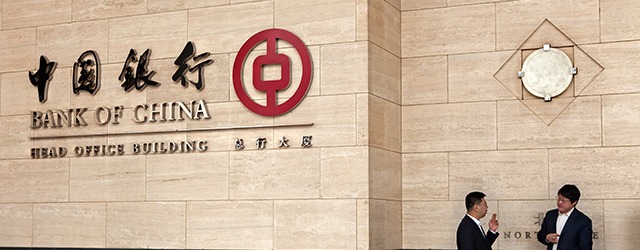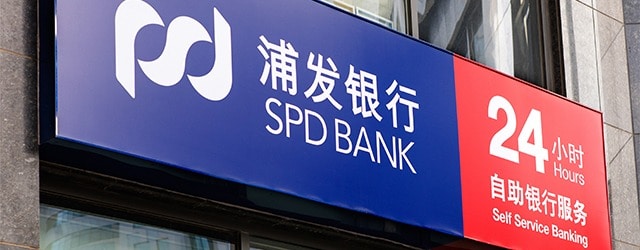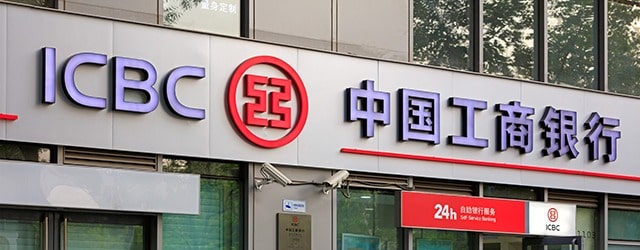China’s banks embrace technology while staying focused on the real economy.

China under President Xi Jinping has had a difficult passage through 2019, punctuated by a slowburning trade war with the US, wildly fluctuating renminbi-dollar exchange rates, and volatility in the economically critical domestic property market. Foreign companies doing business in China have found themselves under scrutiny at home, and doors are being shut on some Chinese companies operating overseas.
These trials appear to be having little impact on Chinese banks thus far, however. The industry shrugged off a slowing domestic economy and volatile international trade relations last year to post a 4% increase in combined net profit, to 1.83 trillion renminbi ($258 billion). The latest profit report was issued by the China Banking Association, which also heralded last year’s “new leap forward” for improved bank services supporting China’s figurative Main Street, otherwise known as the real economy.
Granted, bankers hit a few bumps. Earlier this year, credit problems prompted regulators to seize a bank in Inner Mongolia, and state-owned lenders were forced to bail out a troubled bank in Liaoning Province.
But the big picture is bright for an industry that stands as a central pillar of the world’s second-largest economy, providing a positive backdrop to what was a robust competition for the Global Finance Stars of China awards for 2019. The competition, now in its 12th year, has been expanded to cover 23 categories.
Winning honors for best-in-China transaction services, corporate banking, innovation, consumer banking and other achievements were 14 domestic banks, three foreign banks, one asset management firm and four companies—including two engineering firms, a textile manufacturer and an agricultural concern. Two domestic winners, ICBC and Bank of China, each received two awards. One bank, Sichuan XWBank, operates through the internet only.
The companies that qualified for the contest have made special contributions to China’s One Belt, One Road overseas development and trade initiative in Africa, Central Asia and Southeast Asia. This year, one company was honored for achievements in Africa, another company was recognized for its efforts in Southeast Asia and two companies shared the Central Asia award.
All winners are being honored in mid-November at a ceremony in Beijing.
“Stars of China showcases financial institutions and companies that bring astute judgment to bear in helping local and foreign clients succeed in China,” says Global Finance Publisher Joseph D. Giarraputo.
The central government’s State Council, the Communist Party of China and Xi himself have emphasized the need for Chinese banks to embrace technological advances such as fintech, with the aim of providing better credit, wealth management and investment services to domestic consumers and encouraging China’s role in global trade.
Banks are also keen to support the government’s push to cultivate overseas business relations, particularly through Belt and Road. A recent report by EY China, a unit of Ernst & Young, titled China Listed Banks 2018 Review and Future Outlook, noted that Chinese institutions—including commercial, state-owned and policy banks—have financed construction projects worth more than $440 billion as part of Belt and Road since the initiative began six years ago.
At home, banks are responding to regulatory requirements for tighter risk controls and lower non-performing loan ratios. According to the Chinese Banking Association, the sector’s total loan balance stood at RMB140 trillion as of January 1, up 12.6% year-on-year, while bond investments jumped 14% to RMB45 trillion and farm lending increased more than 5% to RMB32 trillion. Geographic coverage also rose, and 97% of villages nationwide now enjoy at least basic financial services.
Banks have been expanding the use of smartphone apps and online services. They’ve also embraced mobile payment systems that let consumers pay electronically with a swipe of their smartphones. Working with banks, internet giants Alipay and Tencent Finance now handle most of these transactions, after regulators last year clamped down on smaller services that failed to meet industry standards. More no-cash mobile services are expected as faster 5G internet connections and artificial intelligence expand.
A growing and profitable segment of the banking industry is wealth management, catering to China’s ever-expanding class of high-net-worth individuals. Private banking, investment services and family offices are proliferating as banks increasingly replace financial firms as a go-to resource for the well-to-do. The expansion of Chinese wealth management is also reportedly helping to attract foreign investor interest in Chinese banks. For example, Japan’s Nomura Holdings recently won Chinese regulatory approval for a new securities joint venture aimed, in part, at tapping the wealth management business.
The selection process for this year’s Stars of China competition required a review of individual banking services against the backdrop of a changing business landscape, stable domestic economy and government goals such as poverty reduction, green energy development, overseas business expansion and urban revitalization.
“The economic and financial situation in the first half of 2019 was complicated,” says Sun Jianbo, general manager of the International Business Department at China Construction Bank. “The momentum of global economic growth is weakening. But the domestic economy is generally stable and the main macroeconomic indicators are still in a reasonable range.”
Indeed, Chinese banks are profiting by keeping their primary focus on the real economy at home while scanning the horizon overseas for new business opportunities. Stars of China recognizes the banks whose efforts set them apart from their peers in rising to meet these new opportunities, from developing smartphone apps to leading Belt and Road financing. These institutions set the standards for competitiveness, resilience and adaptability in the country’s banking industry.
|
GLOBAL FINANCE STARS OF CHINA 2019 |
|---|
Category |
Bank |
| Best Corporate Bank | ICBC |
| Best Consumer Bank | Postal Savings Bank of China |
| Best SME Services Bank | China Zheshang Bank |
| Best Bank for Transaction Services | Bank of China |
| Best Bank for Cross-Border Trade | China Construction Bank |
| Best Private Bank | Ping An Bank |
| Best Asset Manager | China AMC |
| Best Domestic Bank for One Belt, One Road | Harbin Bank |
| Best Foreign Bank for One Belt, One Road | Standard Chartered |
| Most Innovative Bank | China Guangfa Bank |
| Star of Innovation in Payments | DBS Bank |
| Star of Innovation in Fintech | Bank of Sanxiang |
| Best Bank for Green Energy Development | Huaxia Bank |
| Best Domestic Bank for Renminbi Internationalization | Bank of China |
| Best Foreign Bank for Renminbi Internationalization | Société Générale |
| Best Bank for Urban Revitalization | Bohai Bank |
| Most Innovative Corporate Merger | Shanghai Pudong Development Bank |
| Best Bank for SOE Reform | Agricultural Bank of China |
| Belt and Road Star of Southeast Asia | China Petroleum Pipeline Bureau |
| Belt and Road Star of Central Asia | Xinjiang Production & Construction Corps and Zhongtai New Silk Road Textile Industry Co. |
| Belt and Road Star of Africa | Sinohydro Corp. |
| China’s Rising Star Bank | Sichuan XWBank |
| Star of Precious Metals* | ICBC |
| Star of Family Office and Wealth Managememt* | China Merchants Bank |
*New award category.
Best Corporate Bank
ICBC
Raw numbers tell the story: The corporate portfolio of China’s largest bank, ICBC, includes 250,000 corporate customers with 4 trillion renminbi ($565 billion) parked in 6.8 million accounts, while the bank’s corporate loan balance stands at more than RMB8 trillion. Size gave ICBC a major advantage in competing for this year’s Stars of China award for Best Corporate Bank.
But there’s more to the story. Like other Chinese banks, ICBC has a mandate to support the country’s real economy in an increasingly challenging environment that includes slowing domestic GDP growth and trade volatility triggered by the US-China trade war.
To support its corporate clients, ICBC has accelerated the application of big data and blockchain in financial products and services. In the past year, it has given special attention to corporate clients in business sectors that are expected to contribute to future economic growth, such as the wellness industry, new energy and advanced manufacturing. It has been particularly keen to support domestic corporates with China projects. For example, ICBC is backing companies working to develop the Beijing-Tianjin-Hebei region, Xiong’an New Area, Greater Bay Area and Yangtze River Delta. Companies involved in the One Belt, One Road initiative are also targets.
ICBC is also sharpening its business skills, for example by reducing its bad loan ratio for a reported 10 consecutive quarters. It established the Chinese banking industry’s first finance training classes for senior executives at private enterprises. ICBC has produced big numbers, but has also displayed the business acumen to prove it’s the best corporate bank in China.
Best Consumer Bank
Postal Savings Bank of China
While its main focus is rural areas including the vast farm sector, Postal Savings Bank of China also supports city dwellers and businesses through its 39,000 outlets nationwide. Its diverse clientele include “the most dynamic participants in China’s economic transformation” and “beneficiaries of national policies” with “diverse financial demands,” the bank says. All this amounts to an extensive mandate requiring a huge commitment to average bank customers, one that Postal Savings has shouldered successfully for decades, helping it win this year’s Best Consumer Bank award.
Postal Savings operates more branches than any other Chinese bank, with 578 million customers, and manages RMB9.2 trillion in assets. Underlining its consumer focus, 86% of all its deposits are in personal accounts, 54% of all loans are personal and 62% of its 2018 operating income came from personal banking.
Postal Savings also looks for ways to leverage its assets. From 2016 to 2018, the bank chalked up compound annual growth rates topping 7% for total assets, 19% for loans and 8% for deposits. This consumer-driven activity has attracted support from global financial firms; last year, the bank signed strategic cooperation agreements with JPMorgan Chase, Fullerton Management, DBS and Tencent.
Best SME Services Bank
China Zheshang Bank
Zhejiang Province is legendary for its entrepreneurial drive, nurturing commercial centers such as Wenzhou and the Hangzhou-based e-commerce behemoth Alibaba. But the Zhejiang spirit is most apparent in its small and medium-size enterprises (SMEs), so much so that shopkeepers who started out there can be found across China. The province is also home to a bank with a reputation for supporting entrepreneurs: China Zheshang Bank, this year’s winner of the Best SME Services Bank award.
China’s banking sector is crowded with SME services, but Zheshang distinguishes itself, in part, by taking the initiative to create securities investment vehicles that provide funds for small-business loans. An example is the recently issued asset-backed security Xuyue 2019-1, which raised RMB2.3 billion. The funds provide backing for small-business bank loans, each valued at less than RMB5 million, thus freeing Zheshang funds for additional loans. The bank’s latest report shows securities-pooled assets supporting more than 900 borrowers with an average loan of about RMB2.3 million.
This and similar products have contributed to impressive growth for Zheshang’s SME credit business. As of June, the bank reported small-business loan balances topping RMB157 billion, up 12% since January. Bank assets totaled RMB1.65 trillion in January, with loans and advances to customers topping RMB865 billion. Not only has Zheshang proven that SME support is good business, but that it can also contribute to a high credit rating; Chengxin International Credit Rating recently gave the bank a AAA rating.

Best Bank for Transaction Services
Bank of China
Globalization is alive and well at Bank of China’s transaction banking division, which focuses much of its attention on integrating multinational enterprises into global industrial chains. Last year, the bank reported combined international and domestic customer transactions topping $1.7 trillion, highlighting its success and qualification for this year’s Best Bank for Transaction Services award.
China’s worldwide business and financial outreach efforts and internet-related growth have fueled the development of new strategies at Bank of China. Recent successes include the creation of “single window” ticket clearing for the International Air Transport Association. In a bow to China’s push to encourage international commerce through free-trade zones, the bank’s transaction services include cross-border yuan and commodity businesses; last year’s cross-border settlements totaled RMB4 trillion. Bank of China has put in place blockchain, big data and other technological applications to streamline transactions, and it offers business clients “one-point docking” to digitally access all available services.
Going forward, the bank plans to continue using transaction services to take advantage of globalization and resource integration, thus more effectively harnessing global service networks. It wants customers everywhere to have access to “cross-currency, cross-time zone and cross-language” transaction systems: an ambitious goal that Bank of China is convinced it can achieve.
Best Bank for Cross-Border Trade
China Construction Bank
Hong Kong’s evolving relationship with mainland China, which oversees the city as a “special administrative region,” is having an enormous impact on regional trade. So banks that serve importers, exporters and other businesses in the Hong Kong area must be adept at cross-border financing. A premier institution in this regard is Bank of East Asia (China), winner of this year’s Best Bank for Cross-Border Trade award.
The 11-year-old, mainland-incorporated unit of the nearly 100-year-old Hong Kong institution of the same name, BEA-China offers a range of innovative cross-border banking and currency services that capitalize on its deep knowledge of the regulatory environments on the mainland and in Hong Kong. Its clients also benefit from a network of offices in dozens of mainland cities.
BEA-China also has branches in Singapore, Malaysia, the US and the UK; and the bank expects its cross-border presence to contribute to strong results going forward. In a recent financial report, BEA chair and CEO David K.P. Li noted that the bank has “established a presence in key overseas markets, and we are leveraging our local knowledge in international markets to promote business flows with China, including Hong Kong.”
Best Private Bank
Ping An Bank
Ping An Bank is neither China’s largest private bank nor its best-known provider of banking services for high-net-worth clients. What comes first for the Shenzhen-based bank, a division of the insurance and financial giant Ping An Group, is an expanding retail business that earlier this year surpassed 90 million customers and last year accounted for 69% of the bank’s net profits.
Ping An Bank is now using that retail base to unlock the potential for growth in its private banking business. In recent years, Ping An has leveraged its retail business by gleaning potential private bank clients from its retail base. Because the effort underscores the bank’s initiative and has met with success, Ping An is this year’s Best Private Bank.
Ping An uses big data to analyze its existing retail clientele in search of customers who qualify for private banking, and then actively recruits them. “Our bank’s existing retail-customer bases already cover a wide range of potential high-net-worth clients,” Li Ming, head of retail, recently told Securities Times. “By constantly mining data, we hope to locate real wealth … and reach them with quality services.”
For private clients, the bank advertises a variety of services, including credit products, equity investment support and “a wealth of offshore business services experience” based on its “leading position in the industry.” On the soft side, the bank offers auto maintenance, golfing and education services.
The effort is paying off. Ping An’s net profit rose 20% to RMB120 billion in 2018. For the first quarter of this year, its total private banking clients climbed 16%.
Best Asset Manager
ChinaAMC
“There is no magic bullet for success,” says ChinaAMC CEO Li Yimei. “What we cherish is a consistent commitment to research.”
That consistency has contributed to the firm’s ability to excel with the largest client base in the industry, earning it this year’s Best Asset Manager award.
ChinaAMC is not shy about its investment and research team, China’s largest. Its portfolio managers average 12 years of industry experience. “Experienced managers have gone through ups and downs, which means they can be cautious when most are greedy, aggressive when the market is jittery,” Li says. The firm’s 200 investment professionals conduct a combined 3,000 visits to listed companies annually. These specialists work under a strict risk-management system, with proposed and executed orders closely monitored for risk and compliance.
ChinaAMC is leveraging the knowledge they amass to partner with foreign firms, including, recently, Fidelity International and Rayliant Global Advisors. The firm is “plugged in” to the mainland’s business network and is “open to more international partnerships to pursue more opportunities in the market,” Li says.
In March, ChinaAMC reported $161 billion in assets under management. Its top-performing fund, ChinaAMC Large-cap Select, has posted annual returns topping 23% since its inception in 2004, making it the country’s strongest A-share market mutual fund, while the ChinaAMC Shanghai-Hong Kong Stock Connect Hang Seng ETF has achieved a 31% return since 2014. ChinaAMC has demonstrated that with consistency and persistence, quality research breeds success.
Best Domestic Bank for One Belt, One Road
Bank of Harbin
A city in China’s far northeast with a door facing Russia is home to a bank that enjoys a geographic advantage and a special knack for supporting One Belt, One Road. Bank of Harbin is a strong facilitator of business ties between companies in China and abroad, especially Russia and Central Asia, earning it this year’s Best Domestic Bank for Belt and Road award.
The National Development and Reform Commission last year included Bank of Harbin in its list of financiers for major construction projects tied to Belt and Road. In 2015, the bank and Russia’a largest lender, Sberbank, founded what is now the 70-member Sino-Russia Financial Council, a platform for regional financial institution interaction. Last year at an economic forum in St. Petersburg, Harbin Chairman Guo Zhiwen was among the few Chinese representatives invited to a meet-and-greet with President Vladimir Putin. The bank cooperates with Russian lenders including the Savings Bank of the Russian Federation, the Russian Agricultural Bank and the Far East Development Fund of Russia.
Initiatives designed to help businesses with international deals have included a lending project aimed at high-tech enterprises, microfinancing programs for small businesses and a China-Russia online services platform for cross-border e-commerce that provides payments, financing and clearing services under one roof. To help Chinese enterprises overcome barriers to Belt and Road projects, such as high financing costs, Bank of Harbin joined with peers in working with the People’s Bank of China to launch crowd-funding-style syndicated lending.
Bank of Harbin handled 60 million rubles ($938,500) and RMB40 million in cash tied to international trading last year and facilitated 58.75 billion rubles’ worth of foreign exchange services. The bank reported an operating profit of RMB74 million for financial services to Russia alone in 2018.

Best Foreign Bank for One Belt, One Road
Standard Chartered Bank
In 2017, Standard Chartered Bank boldly pledged to support China’s One Belt, One Road initiative by facilitating at least $20 billion of relevant financing by 2020. Within a year, the bank had surpassed that goal. Standard Chartered continues to extend support for the Chinese push for global infrastructure development, making it the winner of this year’s Stars of China award for Best Foreign Bank for One Belt, One Road.
Indeed, it would be hard to imagine the initiative reaching many parts of the world without Standard Chartered. Projects in Indonesia, Malaysia, Kenya, Bahrain and Zambia have received major financial support through the bank. It has also worked to forge cooperative ties with key institutions such as China Development Bank.
Standard Chartered reported working on nearly 100 Belt and Road projects last year, about half tied to transportation infrastructure in Africa and South Asia. It is also involved in energy, water and wastewater treatment projects in underdeveloped countries, including solar power projects in India and Vietnam. The bank says it is committed to green development and renewable energy through Belt and Road.
Most Innovative Bank
China Guangfa Bank
Since its early days as one of China’s first joint-stock commercial banks, China Guangfa Bank has cultivated a reputation as an innovative industry leader. To that end, it recently heeded the central government’s call to support the real economy with the rapid rollout of a slew of Main Street–relevant credit products—a key factor in Guangfa’s designation as this year’s Most Innovative Bank.
Recently introduced credit products include e-commerce lending, programs for small and midsize companies and a unique product for mom-and-pop shops and other so-called microenterprises through which a loan application can be processed within one day and funds released within three days. Guangfa has also been recognized for supporting poverty reduction, such as with the Nanchang branch’s programs to help farmers.
The bank also offers a creative approach to transaction services for large enterprises through its Corporate Mobile Banking Platform, which has more than 80,000 clients and handled more than RMB330 billion in transactions in the year ending in February. Business customers also benefit from a variety of insurance services through Guangfa’s largest shareholder, China Life Insurance Co.
As Guangfa’s home territory is one of China’s biggest manufacturing hubs, Guangdong Province, the bank has found innovative ways to support manufacturing supply chains, for example through rapid transaction settlements called “e-second services.” Another product helps distribution companies serve manufacturers; more than 40 companies have participated in the Distributors Financing Project, which offers easy-to-use financing for distribution and storage companies doing business with Guangfa’s manufacturing customers. The project is currently limited to domestic distributors but may expand overseas.
Star of Innovation in Payments
DBS
Elevator manufacturer Schindler China faced a major challenge. It needed to boost efficiency and reduce operating costs and risks stemming from daily transactions involving many banks and currencies. DBS helped Schindler meet the challenge with a single-number bank account allowing domestic and cross-border payments in 11 major currencies. This solution helped DBS secure the 2019 Star of Innovation in Payments award.
Problem-solving has been a catalyst for business for DBS, which opened its first mainland office in Beijing in 1993 and has since expanded to 12 branches focusing on institutional banking and wealth management. DBS reported a year-on-year 17% increase in Chinese cash revenues for the first quarter against the backdrop of a jump in current account savings and call deposit accounts. Customer solution drivers include an automated accounts receivable reconciliation process—a digital platform that connects customers to their accounts on one end and their own clients’ transactions on the other—and a cash-management optimization program that lets corporate customers use digital modeling to simulate various management structures to build the best solution. The modeling system, called DBS Treasury Prism, was localized for the China market last year, attracting interest from state-owned and private enterprises and multinationals.
These and other DBS services are in full play in the Greater Bay Area, a region targeted for economic growth by the Chinese government that includes Shenzhen, Guangzhou and Hong Kong. To facilitate the cross-border payments common in this international area, DBS offers a variety of digital solutions including instant payments and integrated foreign exchange services.
Star of Innovation in Fintech
Bank of Sanxiang
Fintech applications require painstaking development: the kind that helped Bank of Sanxiang win this year’s Star of Innovation in Fintech award.
Since rolling out a five-year plan for science and technology applications in 2018, the bank has moved rapidly to formulate and build fintech-based systems. It takes only about a month to complete each project’s research and development phase. Already, the bank says it has put 41 systems into operation.
One of these integrates blockchain technology and online supply-chain management. For another, the bank is cooperating with Alibaba’s cloud service to centralize office data and forge communication channels and interconnections. Down the road, the bank plans to create a “data lake” for storing its original business information collected from 35 bank systems. Bank of Sanxiang is also building an external data-management platform for accumulating digital assets.
The bank is accelerating fintech approaches to its credit business, too, with the goal of streamlining applications and more easily evaluating credit-worthiness, including models and risk-control rules to allow automatic delivery of data-driven decisions on risk control.
None of these applications has been easy to develop. Alongside Bank of Sanxiang’s tech experts, business customers have been involved to provide perspectives on process design and dealer experience. The result is customized products that put fintech to use to meet the demands of the bank’s customers.
Best Bank for Green Energy Development
Huaxia Bank
China is shifting from fossil fuel–based energy dependence to a renewable energy future through projects such as a recently announced initiative to finance battery storage and renewable energy distribution. The World Bank has unveiled plans for a $300 million loan to jump-start the China Renewable Energy and Battery Storage Promotion Project. And the largest financier, providing at least $450 million worth of support, is China’s Huaxia Bank, this year’s Best Bank for Green Energy Development.
Green financing and related products are built into the Huaxia Bank’s brand promotion. Huaxia offers financing for projects that boost energy efficiency, install clean energy systems, provide environmental protection and support supply chains for various kinds of green equipment. The bank offers targeted credit, leasing, investment and debt financing to support environmentally friendly projects. At a recent conference, a Huaxia executive said a near-term goal is to achieve an annual growth rate of more than 30% for the bank’s green businesses.
Through June, Huaxia reported providing RMB120 billion for real-economy green projects, including RMB7 billion of green bonds and RMB10 billion for its Blue Water and Blue Sky Fund. The bank also offers wealth management products with energy conservation, environmental protection and clean energy themes.
Best Domestic Bank for Renminbi Internationalization
Bank of China
Bank of China has issued the first private placement of financial bonds in China for Bank of Tokyo-Mitsubishi UFJ; promoted economic cooperation with the Philippines through a China bond issue; and helped the United Arab Emirates become the first Middle East country to issue sovereign bonds, worth RMB2 billion, on China’s interbank bond market. Steering international investors into China’s bond market represents just a fraction of BOC’s accomplishments in internationalizing the yuan, however. The list is long enough to make BOC a natural choice as this year’s Best Domestic Bank for Renminbi Internationalization.
Consider its activity in promoting the use of yuan through One Belt, One Road. BOC actively guides companies and governments in Belt and Road countries to use the currency, in part by offering yuan-based loans and facilitating yuan-based trade between overseas buyers and Chinese suppliers. BOC operates more offshore yuan clearing houses than any other Chinese bank, working with institutions as diverse as the Bank of Malaysia and the Bank of Hungary for Belt and Road–related transactions. BOC helped the Philippines issue RMB1.46 billion of Panda Bonds on the Chinese market, encouraging bilateral political and economic cooperation.
BOC’s global scale serves China’s ongoing push to expand yuan acceptance. The bank was the top handler of cross-border yuan settlements last year, topping RMB5.95 trillion.
While the pace has slowed since 2018 due to the US-China trade war and Chinese regulatory controls on capital outflows, BOC is adjusting and may be the best positioned among Chinese banks to continue building international acceptance of yuan.
Best Foreign Bank for Renminbi Internationalization
Société Générale
It has been a decade since Chinese regulators gave Société Générale the green light to begin yuan-based retail banking on the mainland. Since then, acceptance of yuan has spread worldwide with China’s currency-promotion campaign, increasingly globalized trade and One Belt, One Road. Société Générale has meanwhile earned its stripes as a veteran supporter of the Chinese currency by contributing to the yuan’s growing acceptance worldwide, earning this year’s Best Foreign Bank for Renminbi Internationalization award.
Two recent accomplishments stand out as proof of the French bank’s commitment. One was announced year ago, when Société Générale’s Algeria branch facilitated that country’s first yuan settlement. Algerian authorities reportedly overcame reluctance toward using the currency and paid for a China Railway Construction Group refinery project in yuan. The deal was said to clear the way for more yuan-based business in Algeria, where Chinese construction companies have been active for years.
This year, Société Générale and Absa Group, a South Africa-based financial services provider, agreed to support Chinese companies in Africa with cross-continent banking services, including export finance, infrastructure financial advice and cash management. The impetus was the growing presence of yuan-carrying Chinese companies participating in Belt and Road.
Best Bank for Urban Revitalization
Bohai Bank
Banks are at the heart of China’s national strategy for regionally focused megacity development in the greater Beijing, Shanghai and Guangzhou areas. China Bohai Bank, this year’s Best Bank for Urban Revitalization, has its finger on the pulse of development in the Beijing region, which includes the bank’s hometown of Tianjin and nearby cities in Hebei Province.
Bohai provides support for urban revitalization on multiple levels, from serving businesses that power the urban economy to financing major infrastructure projects. For small businesses and family entrepreneurs, it offers online loan applications, working closely with local tax authorities. It can access an applicant’s tax credit and other data, thus providing a rapid response and sidestepping the bottlenecks that small businesses often encounter. Because China-style urban development must also incorporate food production, Bohai supports the region’s agriculture, from vegetable hothouses to meat processing, with credit and other services.
Over the past five years, the bank has also helped finance billions of yuan for transportation-network construction projects, including expressways and industrial parks. A key highway will link Beijing’s next airport and the city of Langfang. Bohai has also gotten behind the construction of Beijing government offices and residential developments in the Tongzhou area and has facilitated nearly RMB10 billion of commercial bonds for area construction enterprises.
Supporting the Beijing-Tianjin-Hebei region’s development has contributed to the bank’s strong financials. Bohai reported a year-on-year 4.8% increase in 2018 net profit to more than RMB7 billion, while total interest earnings shot up 9% to RMB44 billion and total deposits rose 4% percent to RMB606 billion. Bohai is also getting behind smaller urban areas, too. Last year, it opened branches in Ningbo, Shenyang, Qingdao and other cities nationwide.

Most Innovative Corporate Merger
Shanghai Pudong Development Bank
A maturing economy has changed the climate for corporate mergers and acquisitions in China, impacting both domestic deals and outbound bids for foreign companies. Dealmaking has cooled amid a GDP growth rate that dipped to 6.6% last year and could fall another half-point in 2019. According to one report, the 83 M&A deals among A-share companies on the Shanghai Stock Exchange in the first half of 2019 represented a 53% drop from a year earlier.
Yet this climate has given the M&A division at Shanghai Pudong Development Bank a special opportunity to shine, which is why SPD was chosen for the Most Innovative Corporate Merger award.
Rather than any single deal, the award highlights the innovative means that SPD has employed to put M&A services to work. The bank has applied an M&A funding mechanism to create angel investment products targeting technology companies, including in the pharmaceutical and biological sciences sectors. With SPD’s help, tech startups and existing companies seeking expansion funds are directed toward cooperative investment institutions seeking to buy stakes. SPD works out incremental financing and lending for the deals: a type of direct investment that’s unlikely to yield megamergers but makes successful acquisitions more likely.
SPD’s Tianjin branch, for example, arranged an investment in CanSino Biologics, a pioneer in developing affordable vaccines for low-income countries. It was China’s first direct investment in an unlisted technology enterprise. The branch is now working to arrange similar deals after creating a biopharmaceutical fund tied to a RMB1.75 billion M&A fund. The bank says the initiative underscores “a new phase of launch initiatives and deep cooperation for technology-based investment and loan-linked financial services.” SPD is thus successfully adapting to the new M&A environment.
Best Bank for SOE Reform
Agricultural Bank of China
Last year marked the 40th anniversary of both the Agricultural Bank of China and the country’s ongoing reform and opening campaign, which includes a push to streamline state-owned enterprises (SOEs). While ABC has been chiefly commissioned with supporting rural areas and the agricultural sector, it also has had a responsibility for decades to boost national economic initiatives including SOE reform. This earned it this year’s Best Bank for SOE Reform award.
Recent examples of ABC’s support include the rollout of an updated version of an investment fund targeting shares in companies on the reform roster. The fund is one of several that are popular with domestic investors who want to back SOE reform. The bank is also at the forefront of reforming agricultural companies, including several major SOEs, and local government-owned SOEs with operations in rural areas.
As economic conditions change, the focus of reform has shifted away from employee shareholding programs, mergers and mixed-ownership schemes toward productivity improvements and new business strategies. The government in May named 160 SOEs slated for major reform. It has also linked SOE reform to financial transfers from companies to the national pension fund; last year, officials announced that 12 financial institutions would help 53 SOEs transfer RMB603 billion.
Belt and Road Star of Southeast Asia
China Petroleum Pipeline Bureau
A recent Asian Development Bank report notes that infrastructure development in Bangladeshi cities hasn’t kept pace with urbanization. A major challenge involves providing drinking water to the fast-growing capital of Dhaka, where the local water utility serves 13.5 million people. Soon, the problem will be solved for 40,000 families by a pipeline slated for construction by the China Petroleum Pipeline Bureau, a PetroChina unit and this year’s winner of the Belt and Road Star of Southeast Asia award.
The pipeline is part of a larger project designed to provide safe water for all, and protect the environment in Dhaka by 2020. CPPB’s pursuit of a socially significant project outside its oil and gas business reflects the scope of China’s Belt and Road outreach. CPPB has also constructed pipelines for transporting crude oil in Bangladesh, but the Dhaka water project marks a shift in focus.
Belt and Road Star of Central Asia
Zhongtai New Silk Road Textile Industry Co. and Xinjiang Produc-tion and Construction Corps
Farmers struggle to make a living in the mountains and valleys of Tajikistan. A solution was found in a cotton farming/textile manufacturing scheme that today supports farmers and provides hundreds of factory jobs. The companies that executed the solution—China’s Zhongtai New Silk Road Textile Industry Co. and Xinjiang Production and Construction Corps—are co-recipients of this year’s Belt and Road Star of Central Asia award.
Working with the Tajik government, the companies installed a cotton seed-to-yarn production chain that includes irrigated fields and a spinning plant and introduced upgraded cotton farming techniques. Tajiks hired for factory work received training in China and today earn above-average salaries. The business is now reportedly the country’s largest exporter in terms of foreign earnings, shipping yarn as far as Turkey and Poland. The companies have not only helped improve lives, but also projected an image of Belt and Road as a win-win initiative.
Belt and Road Star of Africa
Sinohydro Corp.
Zimbabwe has long been plagued by inadequate infrastructure, a problem that drew wider attention recently after a water shutoff affected millions of people in the capital of Harare. Through Belt and Road, Chinese companies have been busy with power plant, government building and airport projects in recent years. In March, government officials announced a $237 million commitment by China’s Sinohydro to build four water-treatment plants in Harare. Sinohydro is this year’s winner of the Belt and Road Star of Africa award.
The long relationship between China and Zimbabwe ratcheted up a notch this year when an agreement was signed following a meeting between Chinese Premier Li Keqiang and Zimbabwean President Emmerson Mnangagwa. Sinohydro, which has been building dams and water plants around the world for years under Belt and Road, will contribute by upgrading existing water treatment plants and building new facilities and pipelines. Officials praise the infrastructure project for improving living standards and helping fight waterborne diseases.
China’s Rising Star Bank
Sichuan XWBank
Changsha is a bustling city benefitting from the global success of local equipment manufacturers such as crane-maker Zoomlion and bulldozer-specialist Sany. It’s also home to extremely spicy food, summer downpours—and Bank of Sanxiang, this year’s winner of the China’s Rising Star Bank award and both a contributor to and a beneficiary of Changsha’s success.
Although barely two years old, Bank of Sanxiang is one of China’s fastest growing financiers. Its total capital assets grew some 200% between January and June, to more than RMB22 billion. Loans, deposits and revenues likewise doubled or even tripled. And although the bank reported a modest net profit of RMB7.2 million for the first six months of this year, it’s quickly expanding through mobile banking and other services.
Sanxiang was Changsha’s first private bank when it was launched in 2016 by two principal investors, Sany and pharmaceuticals giant Hunan Hansen. Its goal is to serve retail customers with offerings such as the Lingqianbao investment fund, which can be opened with just 1 yuan, and businesses through services such as a cloud-based payment system for small enterprises.

Star of Precious Metals
ICBC
Zijin Mining Group is one of several major Chinese mining companies benefiting from ICBC’s experience. With overseas assets including a gold mine in Papua New Guinea, copper mines in Serbia and Congo and a zinc mine in Russia, Zijin’s portfolio is generating profits thanks, in part, to the precious metals expertise of the bank. That’s just one reason why ICBC was selected for the Star of Precious Metals award in this year’s Stars of China contest.
In the gold market, for example, ICBC leverages its global reach to link supply and demand in support of Zijin and other Chinese miners that operate overseas, with a range of services including direct and indirect financing, debt financing and asset management. Two years ago, for example, ICBC helped Shandong Gold buy into an Argentinian mine. Last year, an ICBC subsidiary helped Shandong Gold launch an IPO on the Hong Kong Stock Exchange; shares have since risen 30%.
ICBC has more than 500 products—organized under physical precious metals and precious metal trading, financing and asset management—making it China’s most complete bank for precious metals functions. This leading position helped ICBC report average growth last year topping 80% for precious metals transaction volume and 60% in customer numbers.
Star of Family Office and Wealth Managememt
China Merchants Bank
China Merchants Bank, a joint-stock commercial institution that has offered private banking since 2007, tailors a variety of services for high-net-worth individuals, making it an obvious choice for the Star of Family Office and Wealth Management award.
CMB serves first-generation entrepreneurs worried about inheritance through a forum that introduces young, second-generation elites to private banking services. It also sponsors a Young Elites Association for individuals ages 25 to 35 linked to family assets exceeding RMB100 million, aimed at helping them secure long-term prosperity. Fintech also plays a part in the bank’s support for younger clients.
CMB counts some 72,000 clients with more than RMB2 trillion in assets under management, a RMB700 billion increase from 2016. CMB is unique among China’s commercial banks, with a strict system of work training and process management for its client managers. Expert teams guide clients through investment choices and portfolio adjustments, with the goal of maximizing wealth objectives. They issue daily and weekly news and analyses and arrange forums and conferences to keep clients informed.
CMB’s services for clients with assets exceeding RMB10 million have grown rapidly; as of last year, the bank operated more than 68 private banking centers and 64 wealth management centers nationwide. CMB has thus formed a professional bulwark to protect, manage and increase China’s family wealth.



